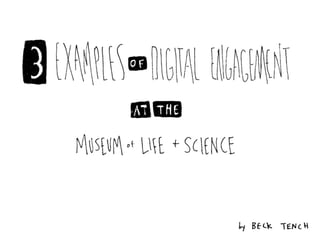Editor's Notes
- #2: Three examples of digital engagement at the Museum of Life and Science by Beck Tench as presented at WebWise 2010 in Denver, CO.
- #3: My position at the museum lives in the “Innovation and Learning” department where I am not bound by the traditional obligations of marketing or IT and where I am given the green-light to experiment and the okay to fail.
- #4: My internal strategy is one of encouragement and education. I want staff to feel safe thinking big and using technology and I want them to feel safe bringing crazy ideas to me.
- #5: Two ways that I foster this is by holding office hours at a local bar on Friday afternoons. Museum folks and locals show up to talk web or the weather, doesn’t matter. We also play a game called “napkin tennis” that serves as a social pacifier and also gives us an opportunity to practice drawing so that in our work we are more comfortable communicating visually. We also have brown bag lunches where we watch TED videos and talk about them.
- #6: My theory is that if staff are comfortable with technology, it can be used to flatten the org chart and get experts closer to visitors.
- #7: My external strategy is one of realism and (benevolent) reuse.
- #8: Realism because it respects the way people use social media. Many institutions think that in the above chart they belong in either the technology (flickr, twitter, etc.) bit or the tribe, but I think we belong in the thought. And that if we can smartly reuse that, the number of users who meaningfully and willfully engage grows exponentially.
- #9: Through smart search algorithms and smart gmail filtering and processing, I can create an institutional database of online activity that can be repurposed as user-generated content. Done on a daily basis, this activity takes me about 5 minutes.
- #10: Our Dinosaurs website shows how we co-create with visitors and with experts without any extra effort on their part.
- #11: This was the original dinosaurs website when it first launched. As you hovered over the colored parts, you were told that your blog entries, photos and tweets about the dinosaur trail would appear on the pages of the dinosaurs they were about.
- #12: Here is the actual page once we had enough content to populate it. The photos and tweets and blog posts (in yellow) were google alerts and tweetbeeps and flickr feeds that I coded in delicious and through an API hook, we are able to display them on the appropriate page. The orange bits below are from paleontology blogs that an exhibit developer manages. We have become the curators of our visitor and scientist voices.
- #13: I received this email from a member of the museum the day after she blogged about the trail. This represents such a huge change in the expectation of a visitor… that if they have something to say about us, we acknowledge it and share it with others.
- #14: Example of digital engagement #1 – the animal keeper’s blog.
- #15: Animal Keepers were traditionally and inaccurately known as “poop scoopers,” both internally and externally. The blog has changed that perception and given them the expert credentials they deserve.
- #16: Additionally, because of the necessary regimen they have to work with in order to keep the animals alive and safe, risk taking is not a part of their regular culture.
- #17: But through technology, a keeper (quoted above) has found a true creative outlet in the blog and feels a since of safety and autonomy in a job where that’s not often the case (and for good reason).
- #18: Our #namethatzoom project was born from a teacher in our museum noticing a popular program (our dermascope) on the floor and asking me what we could make of it online. This turned into a Flickr/Twitter contest every couple weeks where we upload a picture that’s been zoomed in and folks guess what it is on Twitter.
- #19: For this particular zoom, the contest lasted over an hour. And all of the participants were adults.
- #20: This is an audience that has historically eluded pretty much every science center. How do we engage adults?
- #21: For us, our social media audiences are all adults, and this gives us a unique opportunity to appeal to this audience.
- #22: Thanks.





















